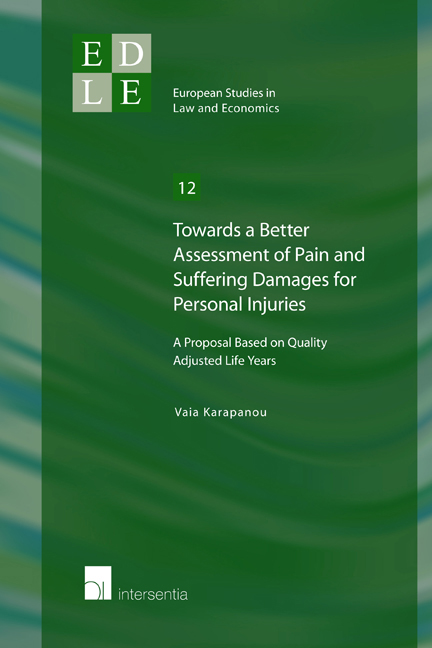 Towards a Better Assessment of Pain and Suffering Damages for Personal Injuries
Towards a Better Assessment of Pain and Suffering Damages for Personal Injuries Book contents
- Frontmatter
- Acknowledgements
- Contents
- Table of Cases
- List of Abbreviations
- List of Tables and Figures
- Chapter 1 Introduction
- Chapter 2 How Should Pain and Suffering Damages be Assessed? A Legal Perspective
- Chapter 3 How Should Pain and Suffering Damages be Assessed? A Law and Economics Perspective
- Chapter 4 Quality Adjusted Life Years. A Measure for the Economic Evaluation of Health Care
- Chapter 5 Using QALYs in a Tort Law Context. Assessing Pain and Suffering Damages
- Chapter 6 Pain and Suffering Damages Based on QALYs. Circumventing Victims' (and Judges') Hedonic Misperceptions
- Chapter 7 The QALY Framework Applied. Practical Examples and Implementation Recommendations
- Chapter 8 Epilogue
- Bibliography
- About the author
- EUROPEAN STUDIES IN LAW AND ECONOMICS
Chapter 4 - Quality Adjusted Life Years. A Measure for the Economic Evaluation of Health Care
Published online by Cambridge University Press: 22 November 2017
- Frontmatter
- Acknowledgements
- Contents
- Table of Cases
- List of Abbreviations
- List of Tables and Figures
- Chapter 1 Introduction
- Chapter 2 How Should Pain and Suffering Damages be Assessed? A Legal Perspective
- Chapter 3 How Should Pain and Suffering Damages be Assessed? A Law and Economics Perspective
- Chapter 4 Quality Adjusted Life Years. A Measure for the Economic Evaluation of Health Care
- Chapter 5 Using QALYs in a Tort Law Context. Assessing Pain and Suffering Damages
- Chapter 6 Pain and Suffering Damages Based on QALYs. Circumventing Victims' (and Judges') Hedonic Misperceptions
- Chapter 7 The QALY Framework Applied. Practical Examples and Implementation Recommendations
- Chapter 8 Epilogue
- Bibliography
- About the author
- EUROPEAN STUDIES IN LAW AND ECONOMICS
Summary
The method used to assess pain and suffering damages should, according to the previous chapters, take into consideration many different factors to be able to attain the goals of tort law as stipulated both by traditional legal theory and by law and economics. On the one hand, to achieve fair compensation and satisfaction, pain and suffering damages should reflect the total health reduction resulting from the personal physical injury. Therefore, factors such as the type, severity and duration of the injury, the pain and emotional strain incurred, as well as the loss in life expectancy, should figure in the assessment. On the other hand, to strike a balance between the goals of deterrence and insurance and promote both goals through the treatment of immaterial losses, pain and suffering damages should be based on the ex ante determined damages, namely the amount that a victim would be willing to forego before an accident occurs to reduce her expected immaterial losses.
Besides the ability to incorporate these features, the assessment should also generate consistent and predictable amounts. Consistency and predictability of the amounts will facilitate deterrence by allowing potential tortfeasors to take into consideration the prospect of having to pay a certain amount of damages if they inflict harm. Furthermore, it may also promote loss spreading by allowing insurers, product manufacturers and service providers to better predict the expected injury damages and incorporate them into the premiums offered. The analysis in the previous chapter showed that the assessment of pain and suffering damages should additionally be as accurate as necessary to reduce the administrative costs of justice. A proposal in this direction is to assess pain and suffering damages by taking into account the average losses resulting from a certain type of injury as well as the age of the victim. In any case, the assessment method implemented should strike a balance between the costs of additional accuracy and the benefits of that accuracy for the attainment of the aforementioned goals.
- Type
- Chapter
- Information
- Towards a Better Assessment of Pain and Suffering Damages for Personal InjuriesA Proposal Based on Quality Adjusted Life Years, pp. 69 - 116Publisher: IntersentiaPrint publication year: 2014


